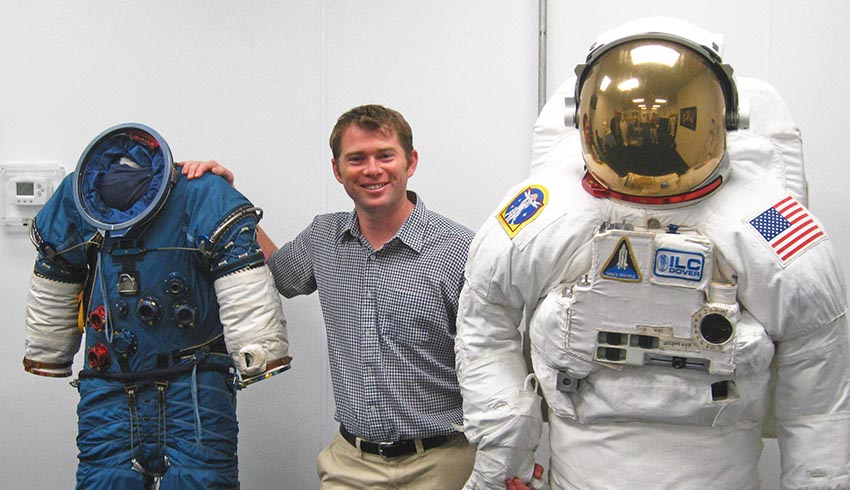The $844,000 Australian Space Agency grant will develop three types of compression space suits, each designed to protect astronauts from the physical strains of space. Two of the designs will be developed as advanced prototypes and one as a concept.
Led by local company Human Aerospace, with RMIT as the primary university partner, the project helps position Australia among global leaders in compression spacesuit technology. This technology is also transferable to medical applications including burns, sports injuries, lymphedema, osteoporosis and cerebral palsy.
Director of RMIT’s Centre for Materials Innovation and Future Fashion, Professor Rajiv Padhye, said his team were eager to contribute their expertise in compression garment design and testing at their state-of-the-art facility.
“This is an exciting opportunity to show our cross-disciplinary teamwork in design and technology and to partner with the best in the world on designing suits that will have real impact on people’s health,” Professor Padhye said.
Director and chief engineer at Human Aerospace, Dr James Waldie, said space travel – let alone exploration of the Lunar or Martian surfaces – took a huge toll on the human body.
Astronauts have been known to grow up to seven centimetres taller as their spines lengthen in weightlessness, leading to back pain during the mission and an increased risk of slipped discs once back on Earth.
Human bodies in weightless space, once unloaded of gravity, also weaken. Astronauts lose muscle and up to 2 per cent of their bone mass every month while in space.
With future missions, such as those to Mars, likely to take well over two years to complete, protecting people from these health impacts presents a major challenge.
Dr Waldie added, “Bone loss is a particular challenge – it’s like an extreme version of osteoporosis. Your hip bones could age by 50 years over a Mars mission.”
The team’s skinsuit helps mitigate bone and muscle loss and other health side effects of weightlessness by imposing Earth-like longitudinal loading on the torso and lower body.
In short, the skin-tight elastic suit has been designed to mimic the impact of gravity on the body.
An earlier version of the skinsuit designed by Dr Waldie flew twice on the International Space Station as part of a European Space Agency programme, where it was assessed for its operational readiness and ability to help reduce spine elongation.
“We were really happy with these initial results but now need to refine it further and progress it into consideration with NASA for future long duration flights,” he said.
The team is also developing an advanced skinsuit concept suit to be worn on spacewalks, moon walks or perhaps even Mars walks.
“Existing gas-pressurised suits for spacewalking are amazing personal spaceships, but they are also bulky, heavy, rigid, unsafe, and require high maintenance,” Dr Waldie explained.
“New designs and advancements are critical in this area too and we think elastic skinsuit pressure layers could work well as an alternative or supplement to traditional gas-pressurised layers in space suits.”
The skinsuit concept for space walks has been around since the 1960s, and Dr Waldie has specialised in researching their development since 2001 while studying his PhD at RMIT University.
“The main challenge is to activate the elastics so that we can manage the pressure and allow them to be donned and doffed easily,” he said.
The third suit being developed by the team is not so much a space suit, as an Earth suit.
In space, blood pressure equalises all over the body. But when astronauts return to Earth the blood is again affected by gravity, and begins to pool at the lower extremities as per normal.
Being unused to the pooling, astronauts can faint from what’s known as orthostatic intolerance.
The team will make an advanced prototype of a compression suit to be worn by astronauts on return to Earth, to help reduce blood pooling, similar in concept to G-suits for pilots.
“This type of technology is not only about aiding the health and safety of astronauts, but also in creating medical technologies to help treat the broader population in cases such as burns, lymphedema and Peripheral Vascular Disease,” he said.
“You might end up designing the suit worn by the first woman on the moon for the 2024 Artemis mission, or the suits worn by the first people to reach Mars.”
RMIT joins Cape Bionics, CQUniversity and TSL as local partners, with a number of international collaborators at NASA, the European Space Agency, Massachusetts Institute of Technology and other renowned institutions.
The project is funded by the Australian Space Agency’s International Space Investment: Expand Capability Grant.

